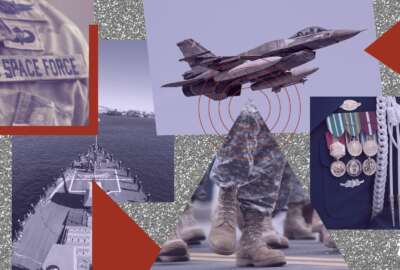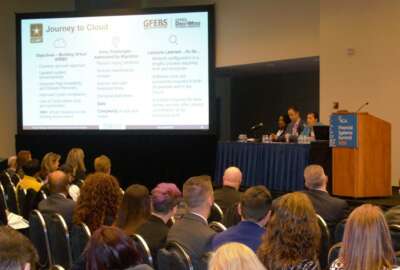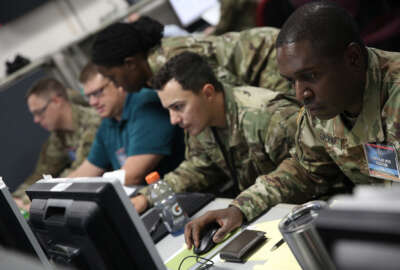Hubbard Radio Washington DC, LLC. All rights reserved. This website is not intended for users located within the European Economic Area.
Army’s 2023 IT, cyber budget request aims to push digital transformation further, faster
Raj Iyer, the Army’s chief information officer, said the Army’s IT and cybersecurity budget request is $16.6 billion in 2023, which is the largest of all Do...
Best listening experience is on Chrome, Firefox or Safari. Subscribe to Federal Drive’s daily audio interviews on Apple Podcasts or PodcastOne.
The Army is expecting fiscal 2023 to be a big year for its digital transformation efforts.
The question, as with most agency programs, is whether Congress will deliver on the Army’s budget request.

“Fiscal 2023, for us, is that year of inflection when it comes to our digital transformation journey,” said Raj Iyer, the Army’s chief information officer, during a press briefing on June 9. “We need to make sure that the investments that we have are appropriately aligned to the Army’s priorities and to the Defense Department priorities, quite honestly through the release of the National Defense Strategy.”
The Army will have to support those priorities, as Iyer and Lt. Gen. John Morrison, the Army’s G6, laid them out in the October digital transformation strategy, through mostly a flat budget request and buttressed by savings from IT modernization efforts.
Iyer said the Army’s IT and cybersecurity budget request is $16.6 billion in 2023, which is the largest of all DoD services. The request makes up slightly less than 10% of the Army’s total budget request of $180 billion.
This was the first time the Army detailed its 2023 IT and cyber budget request since President Joe Biden sent his spending wish list to Congress in March.
Inside that $16.6 billion request is $2 billion for cybersecurity, including offensive and defensive operations, network operations and research and development.
Iyer said the bulk of their IT and cyber investment will go to network support and modernization.
“This is about $9.8 billion. This is clearly supporting all the way from the tactical edge, including the support of current operations, all the way to investments we’re making the cloud,” Iyer said. “Gen. Morrison has spoken about the unified network at a number of events…but 2023 really is also our opportunity to scale our cloud efforts that we have made some tremendous progress in 2021 and 2022. We’re seeing about a $290 million investment in cloud in 2023 to continue to further our cloud migration journey. There’s some tremendous activity across the Army right now in terms of operationalizing the cloud that we’ve established in what we call c-Army.”
Spending less on legacy technology
The Army also is asking for about $220 million for artificial intelligence and data related initiatives.
Iyer said he expects his operations and maintenance (O&M) budget to support current and legacy IT to be slightly lower in 2023 compared to this year as well.
Over the last few years, the Army has been on a path to reduce reliance on old technology and consolidate tools.
Iyer said by moving to Office 365 and through other consolidation efforts, his office has found money to reinvest in modernization.
“One is the convergence of our networks as part of our unified network strategy. We’re looking at converging 42 networks across the Army into that single, unified network. What that will do really is start to consolidate all of the tools into a common service catalog, get us to a common set of processes and to standardization across the network. That will inherently result in in cost savings into 2023,” Iyer said. “Beyond that, there’s some other things that we have done in terms of reducing our bills for 2023 based on our current spending. One of them really is the recent decision to complete or finish out our enterprise IT-as-a-service pilots. We had three contracts in place at three pilot locations that we had selected. Most recently, based on the results and the lessons learned, we have come to a conclusion that we have good data in order to be able to deploy some common services that are cloud enabled across all Army locations worldwide.”
He said O365 is one example of those services. He said his office deploy a standard virtual desktop infrastructure as well in the coming years.
Morrison added that some of the decisions to find savings means getting rid of technology altogether like video teleconferencing hardware and software since the Army can use the capabilities through O365.
“As enterprise capabilities come online, we just need to be ruthless in our governance of it to make sure that we did keep the best of legacy capabilities and we don’t hang on to something just to hang on to it,” Morrison said. “I think we are putting the mechanisms in place to really start getting after that. We’re continuing to shut data centers. We are continuing to leverage the great capabilities that come with c-Army. We’re not doing it at the speed and tempo that we probably can. And quite frankly, Dr. Iyer and I had a discussion just earlier [on June 9] about reinvigorating those efforts because even though we’re past what the goals that had been set for the Army from an efficiency perspective, but I would submit to you more importantly from an operational effectiveness perspective, we need to move a little bit faster and harmonize with this hybrid cloud operational environments. That will only drive us faster toward data centricity. It will only drive us toward a unified network that can support multi-domain operations.”
5 ERPs, 150 support systems
One of Iyer’s biggest and boldest priorities for 2023 that, over the long term, should result in significant cost savings is modernizing the Army’s business systems.
The Army plans to spend $1.4 billion on maintaining five enterprise resource planning (ERP) systems for financial management, human resources and the like as well as 150 support systems.
Iyer said many of these ERP and related systems are more than 20 years old and ready to be updated and moved the cloud.
The Army has been focused on reducing and modernizing its business systems for the last decade. In 2017, the service reported it cut the number of business systems to 400 from 800. In 2020, it upgraded the General Fund Enterprise Business System to be more of a shared service for other Defense agencies and had plans to take the system to the cloud.
“Our marquee effort in 2023 is going to be our implementation or initial prototyping for our new enterprise business systems convergence,” he said. “We’re trying to converge them into a single architecture or into a single system if we can. If we have one integrated capability, then, more importantly, the data that we can pass across that spectrum of operations for analytics. It is a massive, multi-year modernization effort. We fully expect that it will be as high as 10 years for us to get to that modernization effort. But the approach that we’re taking isn’t a big bang approach that we’ve typically used in the past. This is going to meet be more of an evolutionary modernization approach.”
Along with the budget request, Iyer said the Army will take another key step this summer when the Program Executive Office-Enterprise Information Systems (PEO-EIS) will release a call for white papers under an other transaction agreement (OTA) approach to better understand what industry has to offer.
“Since we are going to use an OTA process for this acquisition, there is going to be a lot of interaction with the industry to figure out what’s out there that the Army can adopt rapidly, as well as, ensure we have a future proof architecture,” Iyer said. “We expect to award multiple prototypes in early 2023. These would run anywhere from 12-to-18 months. Then at the end of that effort, just like any OTA, we will get to a production contract by down selecting one of those prototypes to be our production solution.”
Iyer said while the OTA will not be prescriptive, the Army wants to see how industry responds with ideas that include using a modular architecture, supports data exchange through application programming interfaces (APIs) and micro services and is cloud native.
“We’ll be looking at how flexible the solution will be in terms of its ability to implement Army unique processes wherever we have them, without the need to customize commercial off the shelf products,” he said. “This is going to be evolutionary modernization as we are doing this in an agile approach. We will let the functional priorities define what those increments will be, and then we will look at the risk profile to look at how quickly we can get those turned on. That will determine the level of funding and the timeline for implementation. From an implementation perspective, one of the things that we’re going to we’re going to be pushing an industry for is to truly do this using dev/sec/ops and in an agile manner, which means that we are looking for functionality to be available or released to users on rapid sprints, not taking years to do this. This is all about getting functionality in the hands of the user rapidly through agile development.”
Copyright © 2024 Federal News Network. All rights reserved. This website is not intended for users located within the European Economic Area.
Jason Miller
Jason Miller is executive editor of Federal News Network and directs news coverage on the people, policy and programs of the federal government.
Follow @jmillerWFED






